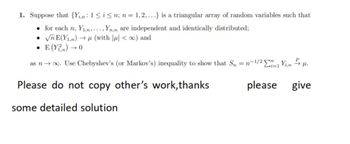
MATLAB: An Introduction with Applications
6th Edition
ISBN: 9781119256830
Author: Amos Gilat
Publisher: John Wiley & Sons Inc
expand_more
expand_more
format_list_bulleted
Question

Transcribed Image Text:1. Suppose that {Yin: 1 ≤ i ≤n; n = 1,2,...} is a triangular array of random variables such that
for each n, Yl,n..., Yn,n are independent and identically distributed;
√n E(Y₁.n) → (with || <oo) and
• E(Y) → 0
as n→ ∞. Use Chebyshev's (or Markov's) inequality to show that Sn = n-1/²1Y₁,n μl.
please give
Please do not copy other's work,thanks
some detailed solution
Expert Solution
This question has been solved!
Explore an expertly crafted, step-by-step solution for a thorough understanding of key concepts.
Step by stepSolved in 4 steps

Knowledge Booster
Similar questions
- 5. Let {S, n>0} be a simple random walk with So = 0 and S₁ = X₁ + ... + X, for n ≥ 1, where X₁, i = 1,2,... are independent random variables with P(X; = 1) = p, P(X; = -1) = q = 1 -p for i>1. Assume p‡q. Put Fo= {2,0}, Fn = 0(X₁, X2, ..., Xn), n ≥ 1. Let b, a be two fixed positive integers. Define T = min{n: S₁ = -a or S₁₁=b}. Assume P(T<∞) = 1. Explain why one can use Doob's Optional Stopping Theorem to conclude that E[ZT] = 1. We can use the conclusion that: T is a stopping time with respect to the o-fields Fn, n ≥ 0. A) B) Define Z₁ = (q/p) Sn, n ≥ 0. {Zn, n ≥ 0} is a martingale with respect to the o-fields Fn, n ≥ 0.arrow_forwardCan I get help on what step I missed?arrow_forward2. Let X₁, X2, X3,..., be independent identically distributed Unif(0, 1) random variables. Let Sn be the largest gap between any two of the points {X1, X2,..., Xn} (e.g. if n = 3 and (X₁, X2, X3) = (0.1, 0.5, 0.7) then S3 = 0.4). Show that for any x > 0 lim P(nSn > x) = 1. n→∞ Hint: to lower bound nSn > x, if suffices to demonstrate that there is an empty interval of some length x/n which contains none of the points. Make a list of some candidate intervals and then use Cheby- shev's inequality to show one of them is empty with probability going to 1.arrow_forward
- 1. Suppose that X1 and X2 are independent random variables having the uniform dis- tribution on (0, 1, 2, 3, 4, 5). That is, S) = P{X; = j} = for i = 1, 2 and 0arrow_forward21. Let X1, X2, ... be independent, U (0, 1)-distributed random variables, and let Nm E Po(m) be independent of X1, X2, Set V= max{X1,..., (Vm = 0 when Nm =0). Determine (a) the distribution function of Vm, (b) the moment generating function of Vm. It is reasonable to believe that V is "close" to 1 when m is "large" (cf. Problem 8.1). The purpose of parts (c) and (d) is to show how this can be made more precise. (c) Show that E V, (d) Show that m(1 - V) converges im distribution as m → x. and de- termine the limit distribution. →l as m→.arrow_forwardExercise 13. Let X1,..., Xn ~N (μx, σ²) i.i.d. and Y₁,..., Yn ~N(μy, σ²) i.i.d. with known σ². We assume that for each i the random variables X and Y are correlated, with Corr(Xi, Yi) = 1/2. Define Di = Xi - Y₁ for all i = {1,..., n}. Finally, let X, Y and D be the averages of the Xi, Yi and Di, respectively. a) Show that Cov(Xi, Yi) = 0²/2. b) Determine E(D) and Var(Di). c) Consider the test for Ho: px = μy which uses the test statistic Z = √ND and which rejects Ho, if and only if |Z|> 1.96. Show that P(type I error) = 5%. d) In two or three sentences, discuss the differences between the test from part (c) on the one hand, and the non-paired test for comparing the means of two populations on the otherarrow_forward
arrow_back_ios
arrow_forward_ios
Recommended textbooks for you
 MATLAB: An Introduction with ApplicationsStatisticsISBN:9781119256830Author:Amos GilatPublisher:John Wiley & Sons Inc
MATLAB: An Introduction with ApplicationsStatisticsISBN:9781119256830Author:Amos GilatPublisher:John Wiley & Sons Inc Probability and Statistics for Engineering and th...StatisticsISBN:9781305251809Author:Jay L. DevorePublisher:Cengage Learning
Probability and Statistics for Engineering and th...StatisticsISBN:9781305251809Author:Jay L. DevorePublisher:Cengage Learning Statistics for The Behavioral Sciences (MindTap C...StatisticsISBN:9781305504912Author:Frederick J Gravetter, Larry B. WallnauPublisher:Cengage Learning
Statistics for The Behavioral Sciences (MindTap C...StatisticsISBN:9781305504912Author:Frederick J Gravetter, Larry B. WallnauPublisher:Cengage Learning Elementary Statistics: Picturing the World (7th E...StatisticsISBN:9780134683416Author:Ron Larson, Betsy FarberPublisher:PEARSON
Elementary Statistics: Picturing the World (7th E...StatisticsISBN:9780134683416Author:Ron Larson, Betsy FarberPublisher:PEARSON The Basic Practice of StatisticsStatisticsISBN:9781319042578Author:David S. Moore, William I. Notz, Michael A. FlignerPublisher:W. H. Freeman
The Basic Practice of StatisticsStatisticsISBN:9781319042578Author:David S. Moore, William I. Notz, Michael A. FlignerPublisher:W. H. Freeman Introduction to the Practice of StatisticsStatisticsISBN:9781319013387Author:David S. Moore, George P. McCabe, Bruce A. CraigPublisher:W. H. Freeman
Introduction to the Practice of StatisticsStatisticsISBN:9781319013387Author:David S. Moore, George P. McCabe, Bruce A. CraigPublisher:W. H. Freeman

MATLAB: An Introduction with Applications
Statistics
ISBN:9781119256830
Author:Amos Gilat
Publisher:John Wiley & Sons Inc

Probability and Statistics for Engineering and th...
Statistics
ISBN:9781305251809
Author:Jay L. Devore
Publisher:Cengage Learning

Statistics for The Behavioral Sciences (MindTap C...
Statistics
ISBN:9781305504912
Author:Frederick J Gravetter, Larry B. Wallnau
Publisher:Cengage Learning

Elementary Statistics: Picturing the World (7th E...
Statistics
ISBN:9780134683416
Author:Ron Larson, Betsy Farber
Publisher:PEARSON

The Basic Practice of Statistics
Statistics
ISBN:9781319042578
Author:David S. Moore, William I. Notz, Michael A. Fligner
Publisher:W. H. Freeman

Introduction to the Practice of Statistics
Statistics
ISBN:9781319013387
Author:David S. Moore, George P. McCabe, Bruce A. Craig
Publisher:W. H. Freeman